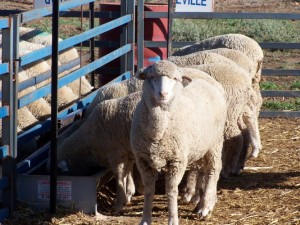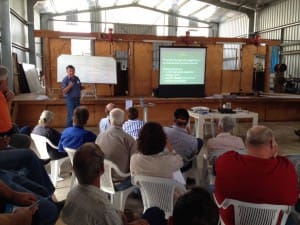Dry conditions have prompted many sheep producers to consider lot feeding lambs this year.
But will it pay?
Well-known private sheep consultant Geoff Duddy, a co-developer of the Sheep CRC’s lamb feedlot calculator, offers a simple rule of thumb for producers to consider.
If the cents per kilogram price a producer can receive for store lambs (about 35kg liveweight/17kg carcase weight) is 85 percent or more of the value on a cents per kilogram basis they expect six weeks later for a trade lamb (22-23kg carcase), they will return a greater profit by simply selling a store lamb.
Using an example to illustrate: a $90 store lamb equals $90/17kg which equals 529c/kg dressed weight (including skin value). If finished and sold six weeks later for $130 ($130/23kg equals 565c/kg) the store lamb’s relative value is 94pc of a trade lamb.
Addressing a recent Leading Sheep field day near Inglewood in Southern Queensland, the Sheep Solutions principal said any producer considering lot feeding lambs should crunch the numbers using the free online feedlot calculator first.
Store lamb prices are again close to the record levels of 2010 and 2011, reflecting the decline in ewe numbers in Australia and the strong opportunistic demand for lambs from producers with available feed.
The extra costs of finishing lambs on grain meant profit margins were lower, and could result in less profit and higher risk compared with selling lambs as stores.
As a ball park figure, Mr Duddy said it typically cost around $55 to grow a lamb to store weight.
Selling that lamb for $85 generated a $30/head profit without the additional costs or resources of undertaking a labour-intensive feeding program.
Breeding stores for south good strategy for Qld producers
Mr Duddy said his main message to Queensland producers in particular was to focus on breeding and keeping lambs alive to sell as stores to the many southern producers looking for lambs to grow out.
“There is just so much demand for a store lamb and we have so few people now breeding. As soon as people get a bit of green feed they want to buy lambs.
“Queensland is primed for this because we need that Merino ewe base and many regions of the State seldom have seasonal conditions that allow Queensland producers to finish lambs to trade or heavier weights.”
‘Queensland is primed for this because we need that Merino ewe base’
The big challenge for Queensland producers was to focus on lifting weaning rates.
Some producers who attended the field day were registering weaning rates well below industry targets of 95-100pc. This was despite scanning 120-130pc lambs in utero, which was typical of an average Merino breeding operation.
While predator impacts were partly to blame, Mr Duddy said work from the Bred Well, Fed Well and Lifetime Ewe programs showed that 75pc of the cause of lamb deaths was nutrition based.
“Most lamb losses occur within 1-3 days of birth with the majority of deaths twin-born lambs from undernourished ewes.
“Under-fed ewes may have lower maternal instincts, slower colostrum/milk letdown and prolonged births.
“This, combined with low birth weight twin lambs with little body reserves, and losses are likely to increase.”
Proven strategies to increase weaning percentages included monitoring the condition of ewes throughout the breeding and production cycle and matching feed to their requirements at each stage.
Weaning percentage was a “huge” profit driver, Mr Duddy said.
“For example, a 10pc improvement in weaning rate has shown to increase profit margins from 13-25pc, depending on enterprise and associated costs.”
Strategies for minimising acidosis
When number crunching does support lot feeding, most producers typically provided lambs with access to grain via a feeder, with sheep either locked up in a small area with separate access to hay or given access to grain while in a paddock to make use of standing feed. The major issue is the need to employ strategies to prevent acidosis/grain poisoning.
Early training of lambs to accustom them to grain went a long way to preventing shy feeders, while buffering additives such as the seaweed extract Acid Buff also helped to minimise acidosis risk.
“Planned, careful management during grain introduction and the strategic use of grains/supplements and feed/mineral additives will help improve lamb survival and growth rates to weaning and, ultimately, their bottom line.”






HAVE YOUR SAY